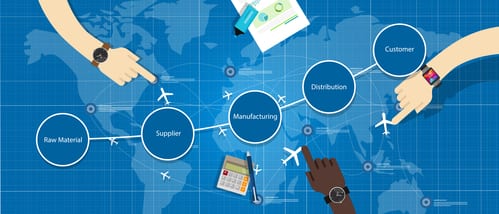{Supply chain transformation overview from CIOPages.com is a hub of many resources for enterprises embarking on transforming their supply chain, including customizable deliverable.}
Worldwide, supply chain transformation has become a strategic imperative for firms to embrace the new economy. The worldwide expansion of the internet has highly propelled E-Commerce, which can be defined as follows: “E-Commerce is the purchasing, selling and exchanging of goods and services over computer networks – internet – through which transactions or terms of sale are performed electronically.” Undoubtedly, this is fundamental trend driving Supply Chain Transformation.
We live in a time in which consumers are demanding and expecting all store owners to offer a multi-channel shopping experience, delivered seamlessly across mobile, online, and in-store merchandising platforms. The Omni-Channel “mandate” is mainly driven by the impact of digitization – smart phones, tablets and high speed internet connection which have become the norm.
Current statistics show that the largest E-commerce markets are China and United States with $570 billion and $350 billion respectively. Nonetheless, the most interesting fact is the extremely high pace at which E-commerce is driving sales growth.
According to E-Marketer, by 2019, retail e-commerce sales will increase to $3.578 trillion, representing 12.8% of total retail purchases. Even though these percentages are relatively small, e-commerce is continuously growing and it is therefore expected to reach higher levels in the near future.
E-Commerce is here to stay. Not only in retailing, but also throughout different industries are businesses starting to realize its potential. Indeed, its scope has gone beyond B2C to extend to B2B as well. It is certainly a sustainable driving force for growth.
An E-commerce platform is considered an essential capability, so is the supply chain and it’s transformation to the digital age. At its heart lies the core commerce functionality that supports pricing, promotions, the shopping cart, and the actual purchase transaction.
Forrester highlights that experience management, product information management and order management are considered advanced capabilities. Precisely, vendor available options differ in the advanced capabilities, since the market for essential capabilities is in the mature stage.
The top five E-retailer sites for 2016 listed by Deloitte are Amazon, Apple, JD.com, Walmart and Otto (Germany). Alibaba and E-Bay are top performers within E-commerce, by acting as a middleman between buyers and sellers online and by facilitating the sale of goods between the two parties through its extensive network of websites. And here is a list of top 25 e-commerce sites.
Online shopping is up by 45% in 2016 with smart phone revenues taking over desktop revenues. In accordance to Criteo, by the end of 2015, the mobile share of global E-commerce transactions was over 40% and it is expected to reach 70% by 2017.
Within E-commerce, we can distinguish B2C and B2B. The former is the E-commerce model that gets more attention from the media. Basically, it is the direct trade between the company and consumers. Goods and services are sold online.
Even though B2C has reached higher levels in popularity, B2B is the biggest revenue generator globally. The entry of E-commerce giants such as Alibaba and Amazon into B2B has boosted B2B websites, becoming more like B2C.
We live in a time in which consumers are demanding and expecting all store owners to offer a multi-channel shopping experience, delivered seamlessly across mobile, online, and in-store merchandising platforms. The Omni-Channel “mandate” is mainly driven by the impact of digitization – smart phones, tablets and high-speed internet connection which have become the norm. Omnichannel, while it makes conceptual sense, has tremendous implications on supply chain to the meet the anytime, anywhere, any-how paradigm.
E-commerce demands an agile and integrated supply chain to meet customers’ expectations. This implies retooling the supply chain by redesigning warehouses and training employees, with the goal of streamlining processes, whether they buy online or in-store. This omnichannel strategy requires a far more complex and interconnected supply chain. And that is where supply chain transformation to compete in the digital age becomes a paramount consideration.
For lean supply chain, we have considered manufacturing as the example, since it has its origins with Ford and then continued with Toyota, as explained above. For the agile supply chain, we are going to consider retailing as the main example.
In accordance to “Strategy&” (formerly Booz & Company), regardless of having physical locations or not, every retailer must respond to the increasing and restless digital consumer base. This is becoming critical. In accordance to the statistics, even though overall retail sales do not increase, online sales are expected to go up at a compound annual growth rate of 10%, with some categories such as food and beverage, jewelry and health and beauty, by 15% year over year online.
To deliver this desirable shopping experience, we must implement an optimal multichannel supply chain – efficient and scalable – to meet the company’s overall channel strategy and meet the customer’s requirements and expectations.
Creating a multichannel supply chain is very challenging due to different objectives and priorities of traditional and online retail supply chains. For instance, in the physical retail environment, the goal through supply chain is to efficiently keep the products that consumers want most available on the shelf, with rapid replenishment from regional distribution centers. For online channels, customer value is driven by the ability to offer a much wider variety, and the possibility of customize products that the retailer ships from a central warehouse.
The difference in logistics costs is significant. For retailers, transportation costs are kept relatively low through a network of regional distribution centers. However, in the online channels, logistics costs are extremely high, as most products are shipped directly to the consumer’s homes or offices individually or in small groups by parcel carriers.
